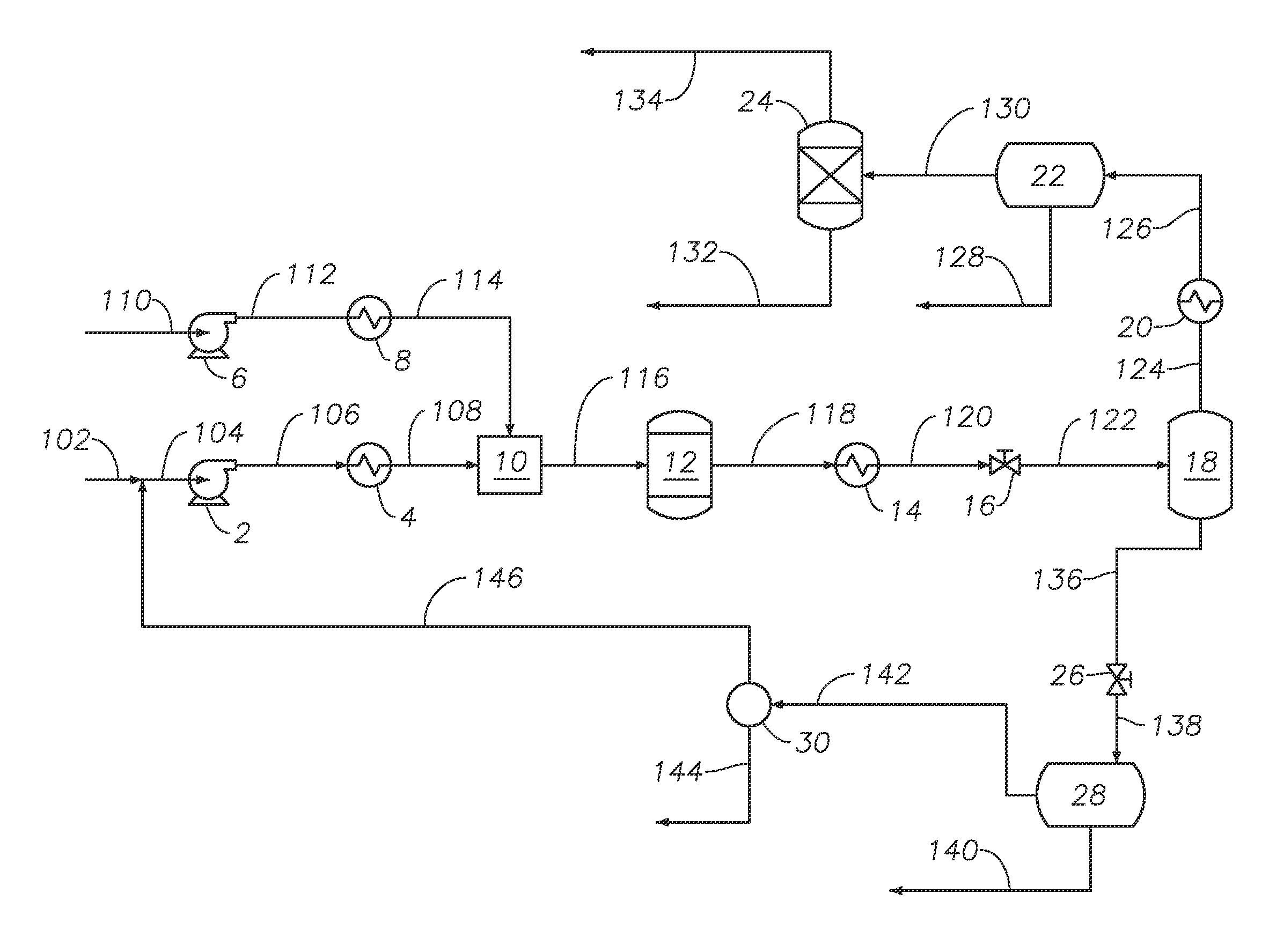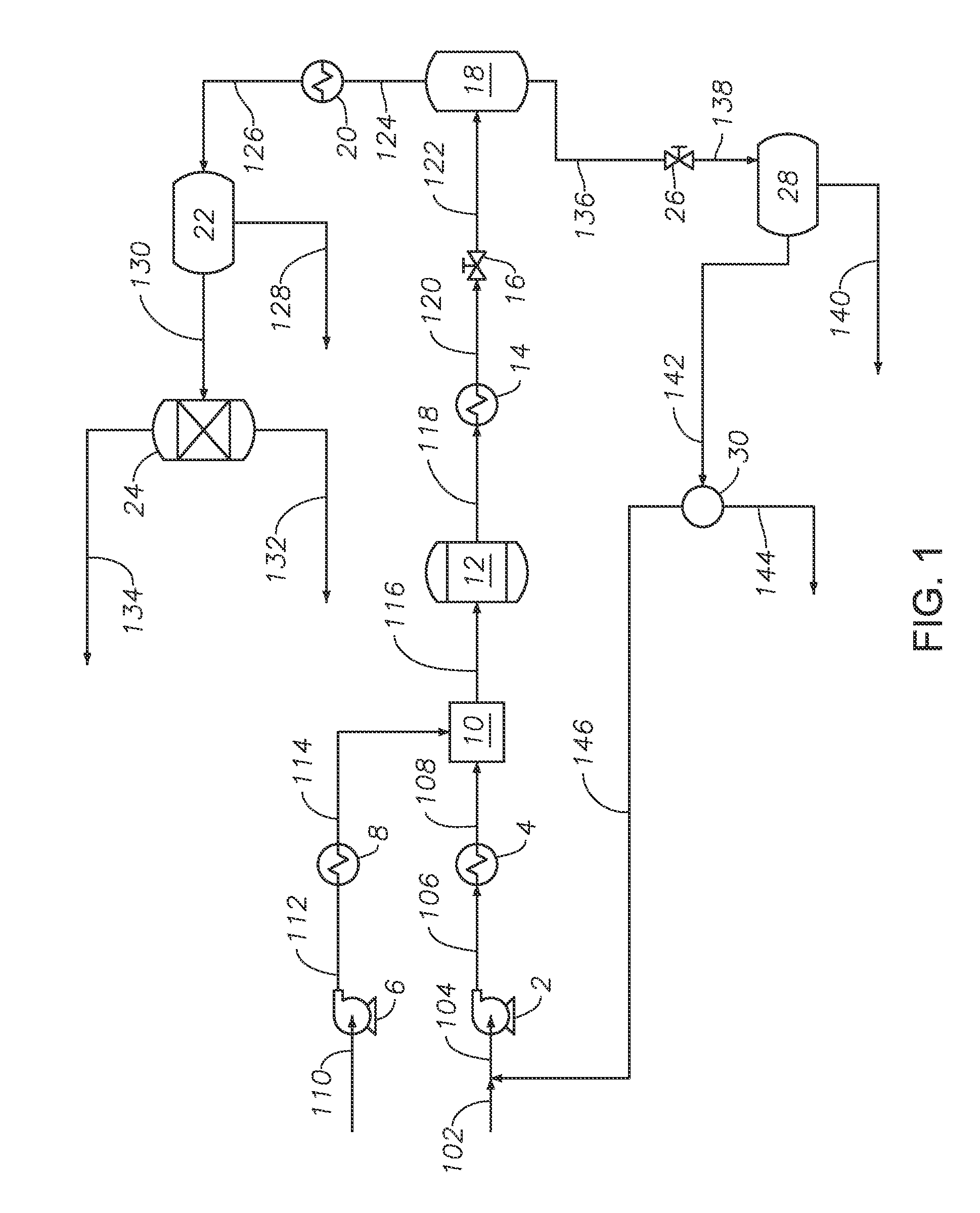Process to produce aromatics from crude oil
a crude oil and aromatic technology, applied in hydrocarbon oil treatment, hydrocarbons, thermal non-catalytic cracking and other directions, can solve the problems of unknowable compositions of crude oil or upgraded oil streams, unfavorable fcc units, and high catalyst costs, so as to improve api gravity, reduce sulfur content, and improve the effect of api gravity
- Summary
- Abstract
- Description
- Claims
- Application Information
AI Technical Summary
Benefits of technology
Problems solved by technology
Method used
Image
Examples
example 1
[0060]Example 1 provides a simulated model of an embodiment of the present invention as described with reference to FIG. 3. The simulation modeled a whole range Arabian heavy crude oil hydrocarbon source, as mixed petroleum feedstock 104 from petroleum storage 52 at a volumetric flow rate of 20,000 barrels / day was pressurized to a pressure of 3611 psig (24.9 MPa) in petroleum feedstock pump 2 to create pressurized petroleum feedstock 106. Pressurized petroleum feedstock 106 was pre-heated to a temperature of 50° C. in petroleum feedstock pre-heater 4 to create pre-heated petroleum feedstock 108. Water stream 110 from water storage 50 at a volumetric flow rate of 20,000 barrels / day was pressurized to a pressure of 3611 psig (24.9 MPa) in water pump 6 to create pressurized water stream 112. Pressurized water stream 112 was pre-heated first in a cross exchanger operation with modified stream 118, in reactor cooler 14 to create heated water stream 300. Heated water stream 300 was heated...
example 2
[0062]Comparative Example. Example 2 used the same simulated model and inputs as Example 1, with one notable difference. The set-up of reactor 12 was different in Example 2, specifically the second reaction zone had an internal temperature of 400° C. and a residence time of 1 minute. Table 4 shows selected components of selected streams.
[0063]Table 5 suggests that the content of benzene, toluene, and xylene in stream 132 is sensitive to the operating conditions of reactor 12.
TABLE 4Comparative Example of Selected Components of Selected StreamsMass flow (kg / hr)Stream 102Stream 122Stream 132Benzene46492Toluene381661603p-Xylene749178m-Xylene163189163o-Xylene130145120
TABLE 5Comparison of the Aromatic Extract StreamMass flow (kg / hr)Example 1Example 2Benzene102Toluene913603p-Xylene9278m-Xylene207163o-Xylene145120Total BTX of 10001367966
example 3
[0064]Deionized water and whole range Arabian Heavy crude oil (API gravity at 60° F.=26.5°) were pumped by independent metering pumps at the rate of 0.96 liter / hr and 0.62 liter / hr, respectively. Pressurized water and crude oil were pre-heated by independent electric heaters to reach at 513° C. and 50° C., respectively. Two pre-heated streams were combined by a tee fitting. The first reactor had 1 liter internal volume and impeller-type agitator to enhance mixing of water and oil. The second reactor had 0.25 liter internal volume and impeller-type agitator too. The temperatures of the reactors were set to 400° C. and 430° C. for the first and second reactors, respectively. Reactor effluent was cooled down by double pipe type heat exchanger to be lower than 50° C. Stream was depressurized by back pressure regulator to atmospheric pressure. Product was separated into water and oil by using centrifuge machine and oil product was analyzed by distillation and gas chromatography. The amou...
PUM
| Property | Measurement | Unit |
|---|---|---|
| temperature | aaaaa | aaaaa |
| temperature | aaaaa | aaaaa |
| temperature | aaaaa | aaaaa |
Abstract
Description
Claims
Application Information
 Login to View More
Login to View More - R&D
- Intellectual Property
- Life Sciences
- Materials
- Tech Scout
- Unparalleled Data Quality
- Higher Quality Content
- 60% Fewer Hallucinations
Browse by: Latest US Patents, China's latest patents, Technical Efficacy Thesaurus, Application Domain, Technology Topic, Popular Technical Reports.
© 2025 PatSnap. All rights reserved.Legal|Privacy policy|Modern Slavery Act Transparency Statement|Sitemap|About US| Contact US: help@patsnap.com



